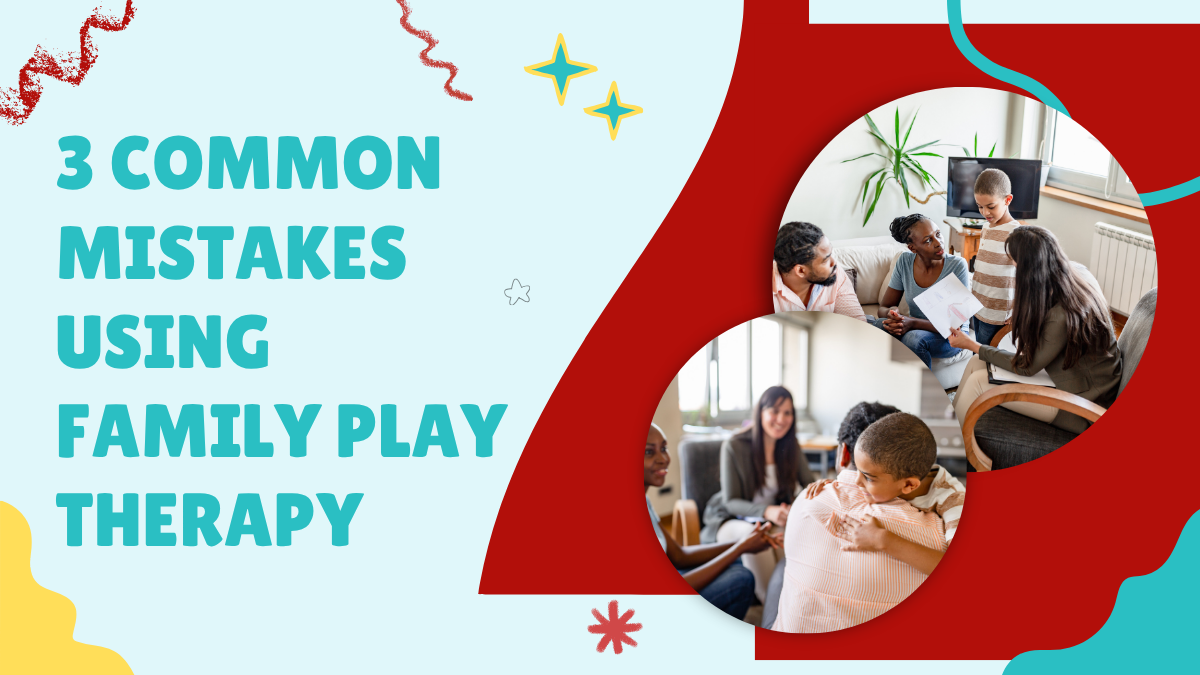3 Common Mistakes Using Family Play Therapy

Family play therapy has the power to transform. It’s where patterns come to life in real time, where healing moments can ripple out into daily life—and yet, so many play therapists white-knuckle their way through these sessions.
Whether you're letting parents in at the child's request or inviting the whole family system in as part of a deliberate treatment plan, things can get messy quickly. But mess doesn’t mean failure. More often, it means there are some invisible traps at play—and you don’t have to fall into them.
Here are three of the most common (and sneaky) mistakes I see play therapists make when using family play therapy—and what to do instead.
Mistake #1: Treating It Like Individual Play Therapy "Plus"
You’re in the waiting room. Your client asks, “Can my mom come in today?” You say yes. Then the session feels off.
Parents sit on the sidelines. You feel awkward. You're suddenly performing, hoping parents understand the method behind the magic of play. And when the session spirals or a tantrum erupts, you wonder what went wrong.
This is what I call the "individual play therapy plus" trap. It's when we invite parents into the playroom without making a fundamental shift in our thinking. What we end up doing is keeping our individual therapy mindset while letting others tag along—and it doesn’t work.
When you shift to a family play therapy model, everything changes. You start thinking systemically. You begin to see the entire family as the client. And more importantly, you’re no longer the sole agent of change. Parents become your partners. They stop being observers and become engaged participants. That’s when real growth begins.
Mistake #2: Not Preparing for the Chaos
Let’s be honest—chaos in family sessions is going to happen. And that’s not necessarily a bad thing.
You might worry that involving parents and siblings will derail progress. But here’s the truth: what you see in the playroom is likely what’s happening at home. When you invite the system in, you get to see patterns in real time—and so do the parents. That shared experience is validating and powerful.
The real mistake? Not preparing parents. When there’s no clarity around roles or expectations, families flounder. You need to prep them—before they ever step into the session.
-
What’s their role?
-
What’s yours?
-
What happens if misbehavior occurs?
-
What’s the goal of the activity?
Family play therapy isn’t about you doing all the heavy lifting—it’s about coaching parents to become the therapeutic agent of change between sessions, too. And that starts with giving them the tools they need to succeed.
Mistake #3: Winging It Without a Framework
You can’t prep parents if you don’t know what you’re doing either. And that’s not a dig. It’s an invitation to choose a model.
Your framework isn’t just theory—it’s the map you follow. It guides how you think about roles, behaviors, goals, and healing. It’s how you make sense of what’s happening in the room.
Back when I was in grad school (shoutout to all my 1990s classmates), I remember discovering family systems theory and thinking: Ohhh. It’s not just me. That validation—the power of seeing problems as part of a bigger system—completely changed the way I practiced.
Over time, I learned and loved models like filial therapy and Gestalt. But I needed something more integrative—something that accounted for siblings, attachment, neuroscience, and the full family dynamic.
That’s why I developed Attachment-Focused Family Play Therapy, which we dive into in my upcoming training. It gives you a clear framework with defined stages, roles, and practical strategies. It’s the glue that ties it all together—and avoids the “just wing it and hope” trap that so many therapists fall into.
So What Now?
Let’s recap.
-
Don’t just tack parents onto individual sessions—shift to a systemic mindset.
-
Expect (and embrace) chaos—but prepare parents so they’re empowered, not sidelined.
-
Choose a framework and use it. Let it anchor your sessions, roles, and structure.
And if you want help doing that?
➡️ Join the Attachment-Focused Family Play Therapy Training happening November 8th. You’ll walk away with a full framework you can start using right away—plus insights into neuroscience, attachment, and how to navigate every stage of the process.
➡️ If you’re looking for deeper support, consultation, or community, Play Therapy Academy has openings right now. We meet twice a month for case consultation, provide course-based learning, and offer a community where we can keep growing together.
➡️ And Play Therapy Elevation CIRCLE, my new online membership for play therapists looking for community and support, is opening again soon and you can join the waitlist here.
You don’t have to white-knuckle your way through family sessions anymore. Let’s do this on purpose—and with a plan.
Categories: : Attachment-Focused Family Play Therapy, Community, Play Therapy, Play Therapy Academy, Play Therapy Elevation Circle, Play Therapy Model, Role of parents
 Cathi Spooner
Cathi Spooner 
